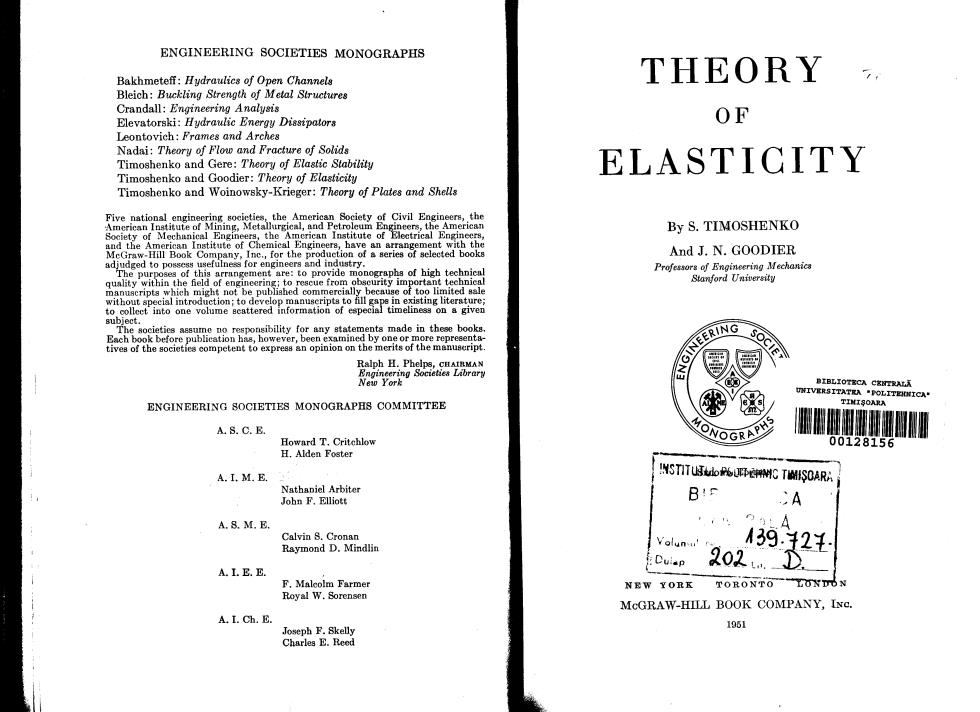
ENGINEERING SOCIETIES MONOGRAPHS Bakhmeteff:Hydraulics of Open Channels THEORY Bleich:Buckling Strength of Metal Structures Crandall:Engineering Analysis Elevatorski:Hydraulic Energy Dissipators OF Leontovich:Frames and Arches Nadai:Theory of Flow and Fracture of Solids Timoshenko and Gere:Theory of Elastic Stability ELASTICITY Timoshenko and Goodier:Theory of Elasticity Timoshenko and Woinowsky-Krieger:Theory of Plates and Shells Five national engineering societies,the American Society of Civil Engineers,the Amcrican Institute of Mining,Metallurgical,and Petroleum Engineers,the American By S.TIMOSHENKO Society of Mechanical Engineers,the Amcrican Institute of Electrical Engincers, and the American Institute of Chemical Engineers,have an arrangement with the MeGraw-Hill Book Company,Inc.,for the produetion of a series of selected books And J.N.GOODIER adjudged to possess usefulness for engineers and industry. The purposes of this arrangement are:to provide monographs of high technical Professors of Engineering Mechanics quality within the field of engineering;to rescue from obseurity important technical Stanford Universit到 manuscripts which might not be published commercially because of too limited sale e e ocere nfe subject. The societies assume no responsibility for any statements made in these books. Each book before publication has,however,been examined by one or ore representa- tives of the societics competent to express an opinion on the merits of the manuseript. Ralph H.Phelpe,CHAIRMAN Engineering Societies Library New York IBLIOT含CAC客TAi UNIVERSITATRA .POLITERNICA ENGINEERING SOCIETIES MONOGRAPHS COMMITTEE TI红8OARA A.S.C.E. Howard T.Critehlow 00128156 H.Alden Foster A.I.M.E. IHST门TUJuloP%L驿IC TIMIS0ARA Nathaniel Arbiter John F.Elliott B:F A A.8.M.E. Calvin S.Cronan Raymond D.Mindlin Yolunu' 39.121 Culap A.I.E.E. 又02.D F.Maleolm Farmer NEW YORK TORONTO LONDON Royal W.Sorensen McGRAW-HILL BOOK COMPANY,INe. A.I.Ch.E. Joseph F.Skelly 1951 Charles E.Reed
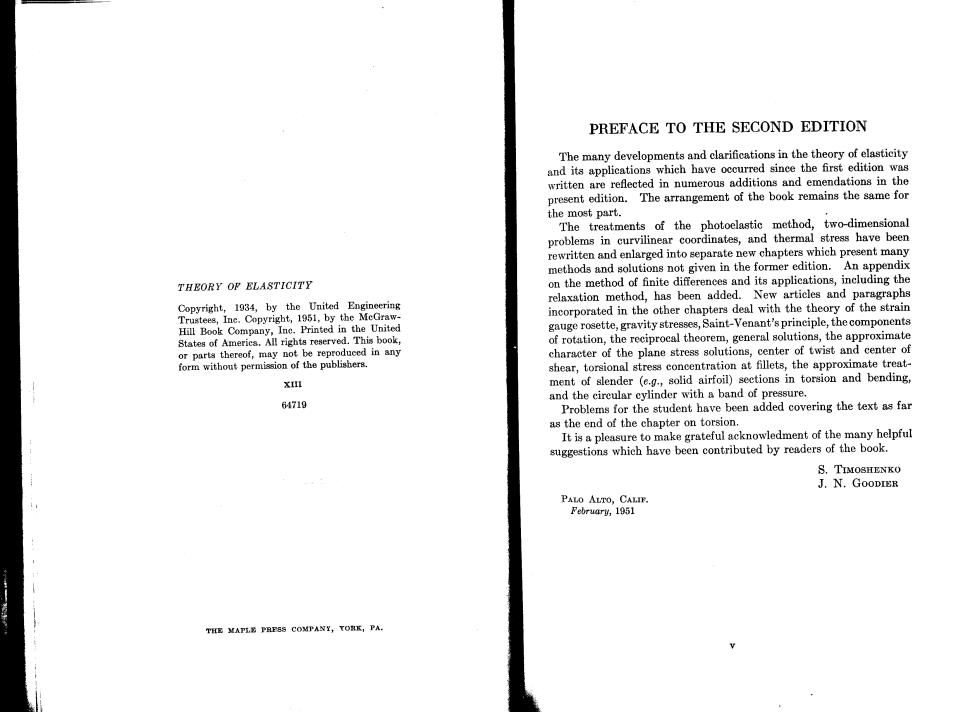
PREFACE TO THE SECOND EDITION The many developments and clarifications in the theory of elasticity and its applications which have occurred since the first edition was written are reflected in numerous additions and emendations in the present edition.The arrangement of the book remains the same for the most part. The treatments of the photoelastic method,two-dimensional problems in curvilinear coordinates,and thermal stress have been rewritten and enlarged into separate new chapters which present many methods and solutions not given in the former edition.An appendix THEORY OF ELASTICITY on the method of finite differences and its applications,including the relaxation method,has been added.New articles and paragraphs Copyright,1934,by the United Engineering Trustees,Ine.Copyright,1951,by the MeGraw- incorporated in the other chapters deal with the theory of the strain Hill Book Company,Ine.Printed in the United gauge rosette,gravity stresses,Saint-Venant's prineiple,the components States of America.All rights reserved.This book, of rotation,the reciprocal theorem,general solutions,the approximate or parts thereof,may not be reproduced in any character of the plane stress solutions,center of twist and center of form without permission of the publishers. shear,torsional stress concentration at fillets,the approximate treat- XIIL ment of slender (e.g.,solid airfoil)sections in torsion and bending, and the cireular cylinder with a band of pressure. 6M719 Problems for the student have been added covering the text as far as the end of the chapter on torsion. It is a pleasure to make grateful acknowledment of the many helpful suggestions which have been contributed by readers of the book. S.TIMOSHENKO J.N.GooDIER PALO ALTO,CALIF February,1951 THE MAPLE PRESS COMPANY,TORK,PA
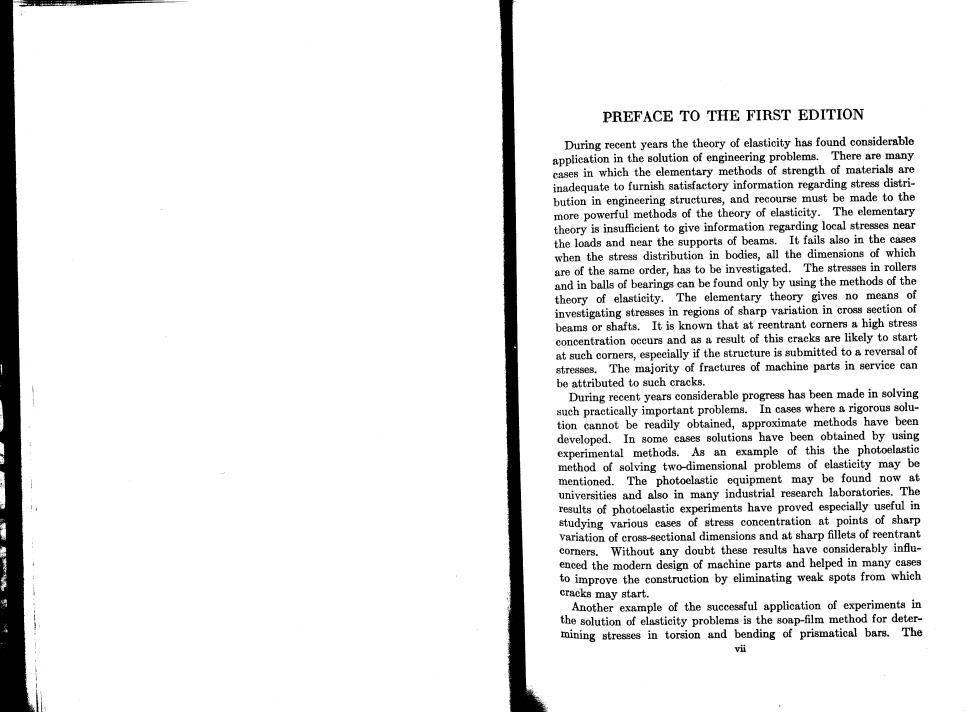
PREFACE TO THE FIRST EDITION During recent years the theory of elasticity has found considerable application in the solution of engineering problems.There are many cases in which the elementary methods of strength of materials are inadequate to furnish satisfactory information regarding stress distri- bution in engineering structures,and recourse must be made to the more powerful methods of the theory of elasticity.The elementary theory is insufficient to give information regarding local stresses near the loads and near the supports of beams.It fails also in the cases when the stress distribution in bodies,all the dimensions of which are of the same order,has to be investigated.The stresses in rollers and in balls of bearings can be found only by using the methods of the theory of elasticity.The elementary theory gives no means of investigating stresses in regions of sharp variation in cross section of beams or shafts.It is known that at reentrant corners a high stress concentration occurs and as a result of this eracks are likely to start at such corners,especially if the structure is submitted to a reveraal of stresses.The majority of fractures of machine parts in service can be attributed to such cracks. During recent years considerable progress has been made in solving such practically important problems.In cases where a rigorous solu- tion cannot be readily obtained,approximate methods have been developed.In some cases solutions have been obtained by using experimental methods.As an example of this the photoelastic method of solving two-dimensional problems of elasticity may be mentioned.The photoelastic equipment may be found now at universities and also in many industrial research laboratories.The results of photoelastic experiments have proved especially useful in studying various cases of stress concentration at points of sharp variation of cross-sectional dimensions and at sharp fillets of reentrant corners.Without any doubt these results have considerably influ- enced the modern design of machine parts and helped in many cases to improve the construction by eliminating weak spots from which cracks may start. Another example of the successful application of experiments in the solution of elasticity problems is the soap-film method for deter- mining stresses in torsion and bending of prismatical bars.The vii
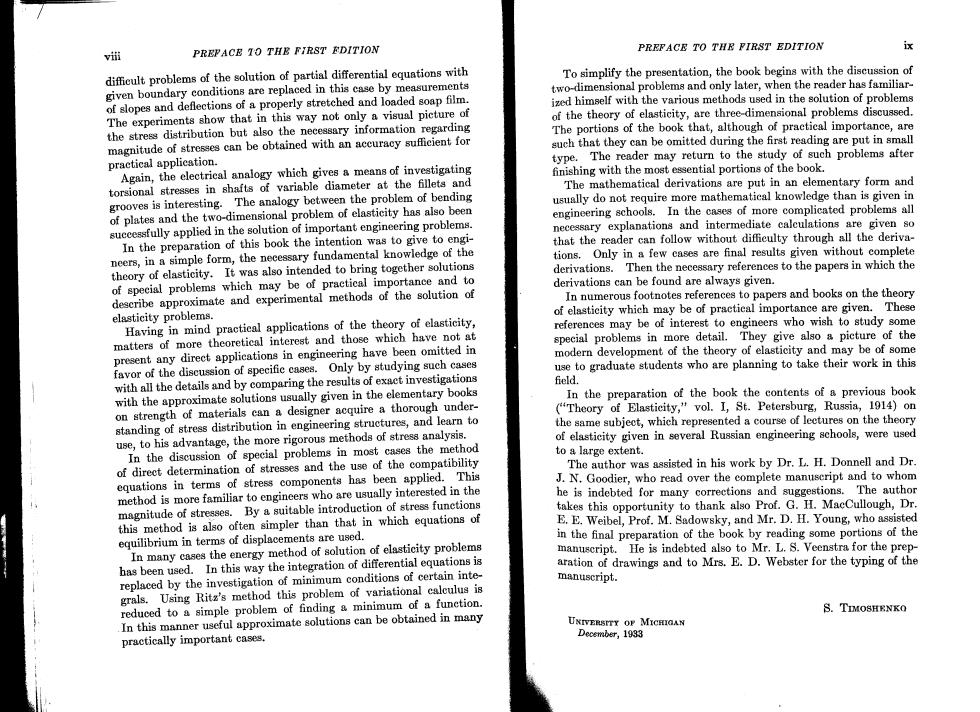
PREPACE T0 THE FIRST EDITION PREFACE TO THE FIRST EDITION ix vi进 difficult problems of the solution of partial differential equations with To simplify the presentation,the book begins with the discussion of given boundary conditions are replaced in this case by measurements two-dimensional problems and only later,when the reader has familiar. of slopes and deflections of a properly stretched and loaded soap film. ized himself with the various methods used in the solution of problems The experiments show that in this way not only a visual picture of of the theory of elasticity,are three-dimensional problems discussed. the stress distribution but also the necessary information regarding The portions of the book that,although of practical importance,are magnitude of stresses can be obtained with an accuracy sufficient for such that they can be omitted during the first reading are put in small practical application. type.The reader may return to the study of such problems after Again,the electrical analogy which gives a means of investigating finishing with the most essential portions of the book. torsional stresses in shafts of variable diameter at the fillets and The mathematical derivations are put in an elementary form and grooves is interesting.The analogy between the problem of bending usually do not require more mathematical knowledge than is given in of plates and the two-dimensional problem of elasticity has also been engineering schools.In the cases of more complicated problems all successfully applied in the solution of important engineering problems. necessary explanations and intermediate calculations are given so In the preparation of this book the intention was to give to engi- that the reader can follow without difficulty through all the deriva- neers,in a simple form,the necessary fundamental knowledge of the tions.Only in a few cases are final results given without complete theory of elasticity.It was also intended to bring together solutions derivations.Then the necessary references to the papers in which the of special problems which may be of practical importance and to derivations can be found are always given. describe approximate and experimental methods of the solution of In numerous footnotes references to papers and books on the theory elasticity problems. of elasticity which may be of practical importance are given.These Having in mind practieal applications of the theory of elasticity, references may be of interest to engineers who wish to study some matters of more theoretical interest and those which have not at special problems in more detail.They give also a picture of the present any direct applications in engineering have been omitted in modern development of the theory of elasticity and may be of some favor of the discussion of specific cases.Only by studying such cases use to graduate students who are planning to take their work in this with all the details and by comparing the results of exact investigations field. with the approximate solutions usually given in the elementary books In the preparation of the book the contents of a previous book on strength of materials can a designer acquire a thorough under- ("Theory of Elasticity,"vol.I,St.Petersburg,Russia,1914)on standing of stress distribution in engineering structures,and learn to the same subject,which represented a course of lectures on the theory use,to his advantage,the more rigorous methods of stress analysis. of elasticity given in several Russian engineering schools,were used In the discussion of special problems in most cases the method to a large extent. of direct determination of stresses and the use of the compatibility The author was assisted in his work by Dr.L.H.Donnell and Dr. equations in terms of stress components has been applied.This J.N.Goodier,who read over the complete manuscript and to whom method is more familiar to engineers who are usually interested in the he is indebted for many corrections and suggestions.The author magnitude of stresses.By a suitable introduction of stress functions takes this opportunity to thank also Prof.G.H.MacCullough,Dr. this method is also often simpler than that in which equations of E.E.Weibel,Prof.M.Sadowsky,and Mr.D.H.Young,who assisted equilibrium in terms of displacements are used. in the final preparation of the book by reading some portions of the In many cases the energy method of solution of elasticity problems manuscript.He is indebted also to Mr.L.S.Veenstra for the prep- has been used.In this way the integration of differential equations is aration of drawings and to Mrs.E.D.Webster for the typing of the replaced by the investigation of minimum conditions of certain inte- manuscript. grals.Using Ritz's method this problem of variational calculus is reduced to a simple problem of finding a minimum of a funetion. S.TIMOSHENKO In this manner useful approximate solutions can be obtained in many UNIVERSITY OF MICHIGAN practically important cases. December,1933
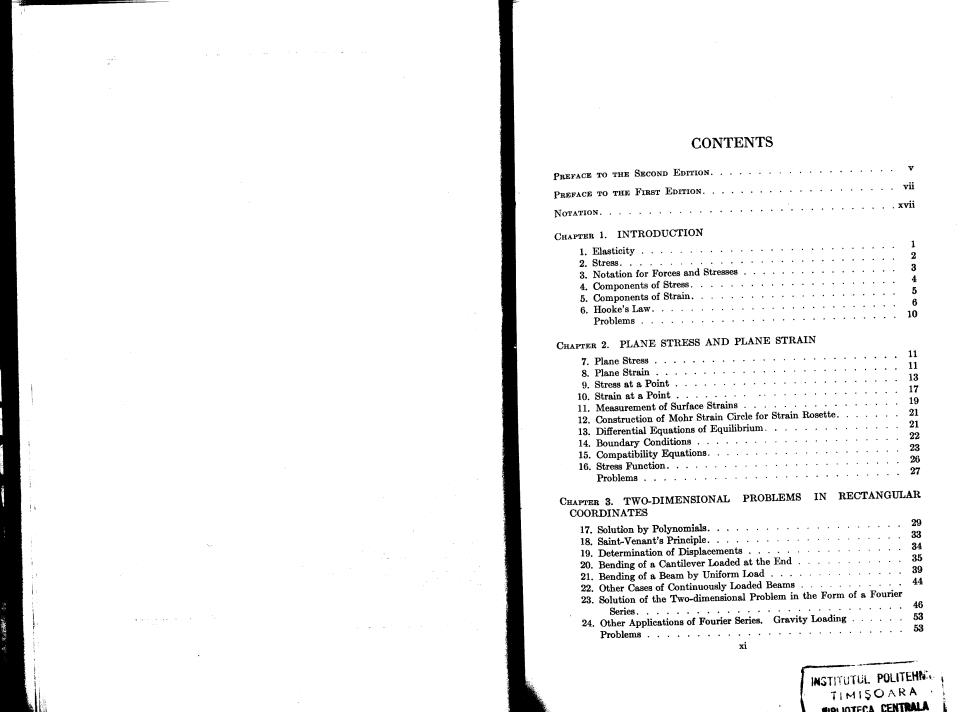
CONTENTS PREFACE TO THE SKCOND EDITION.。。,。。。, PREFACE TO TE%FIRST EDETION.·,,、·,·,。·,,····,。 妙 NOTATION. CHAPTER 1.INTRODUCTION 1 2 2.Stre88.,,, 3.Notation for Forees and Stresses. 3 4.Components of Stress. 5.Components of Strain,·,·,·· G Problems······· 10 CHAPTKR 2.PLANE STRESS AND PLANE STRAIN 7.Plane Stre8s········,··· 11 8.Plane Strain,.。,.。,。.··,··· 4 11 9.Ste88 t a Point,.········· 培 10.Strain at a Point.... 11.Measurement of Surface Strains. 9 12.Construetion of Mohr Strain Cirele for Strain Rosette. l3.Differential Equations of Equilibrium.。。。.。,,· 2 14.Boundary Conditions,.·。·······,, 15.Compatibility EquationB.,。,。。,,.,,,, 23 16.8 tress Function.,,··+······+,·- Problem。··t4··”4 马 CHAPTER 3.TWO-DIMENSIONAL PROBLEMS IN RECTANGULAR COORDINATES 17.Solution by Polynomials. 39 18.Saint-Venant's Prineiple. 19.Determination of Displacements 4 20.Bending of a Cantilever Loaded at the End 3 2l,Bending of a Beam by Uniform Load.·,·, 22.Other Cases of Continuously Loaded Beams. 44 23.Solution of the Two-dimensional Problem in the Form of s Fourier Series. 46 24.Other Applicntions of Fourier Series.Gravity Loading...... 53 Problems,,,,···· xi INSTITUTUL POLITEHN. TIMISOARA OTECA CENTRALA